Meenakshi and modernity
Here is an email I mailed to the Archaeological Survey of India in January 2012. It was never answered, and nothing has been done.
---------- Forwarded message ----------
From: Ryan Lobo
Date: Mon, Jan 30, 2012 at 11:28 AM
Subject: The Meenakshi temple. Madurai
To: directorgeneralasi@gmail.com
Cc: adg1.asi@gmail.com, adg2.asi@gmail.com, jtdg.asi@gmail.com, nationalmission@gmail.com, dircon.asi@gmail.com, dirwh.asi@gmail.com
Dear Mr. Sengupta and all other concerned authorities at the Archaeological Survey of India,
My name is Ryan Lobo and I am a photographer and film maker based in Bangalore. On a recent trip to the Meenakshi temple a few days ago, in Madurai, I photographed some changes being made to the temple, which I found (with my layman’s knowledge of our monuments) to be potentially destructive to the preservation of this temple for future generations.
I am attaching some of these photographs as I wish to bring this state of affairs to your attention. Please do pardon my presumption, a possible lack of knowledge on these matters and do forgive my errors in judgment, if any. My intentions are to help in the ASI's efforts in preservation in whatever way I can.
I understand that the temple is a living temple but one also needs to keep in mind its preservation. The current aesthetic or capacity of the local administration of the temple should not damage the structure for future generations.
1.The Ceiling
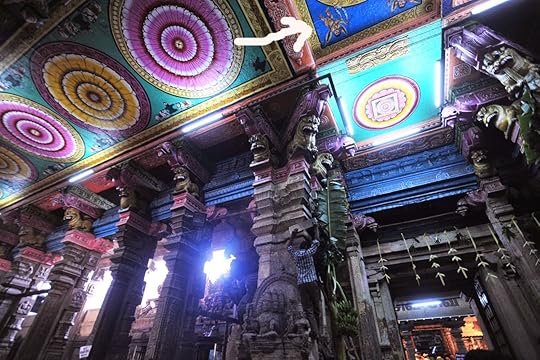
The stone ceiling has been and is being painted with motifs not necessarily in keeping with the history or mythology of the temple. i.e. Kindly note what seem to be cupids on the top right hand corner of the photo.
Tube lights are being installed all over the temple unnecessarily.The ceiling has also been painted with Enamel paint by a painter not necessarily as talented as the original sculptors of the temple. The temple might not need such embellishments, which could damage the stone as the pores do draw in the paint. The sensibilities and aesthetics of the painting seem to be more contemporary and keeping with more recent trends and ways of looking at the world rather than with the temple aesthetic.Signs, often large, painted brightly and unnecessary, are placed all over the temple. Loudspeakers (such as the one visible near "meditation hall") in photo: signs and ceiling disturb the aesthetic.
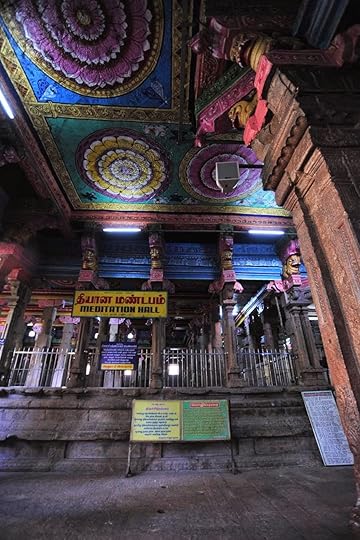
2. The Temple pond (Kindly refer photo)

A pile driver is being used to break the base of the temple pond as seen in the photograph (a.). The workman did say they were "re-tiling" the pond with "modern" tiles. The vibrations from a pile driver can damage a structure and one could feel the stone vibrate 50 meters away. This usage can damage the structure in ways not visible and can damage delicate sculptures.The large slabs of granite from the pond are being broken and removed and taken away as debris, as show in the debris photo. Is it necessary to "modernize" the tank? as I was told by the foreman instructing the labourers.
The pond has also been changed in some regards with an ornate contemporary lamp post (b) in the middle and unnecessary "gardens" in the corners (c). Large ugly tube light lit signs are present all over the temple as well. (d). The temple has been painted with glossy enamel paint all over. Even if painting is allowed should not non-enamel pigments be used?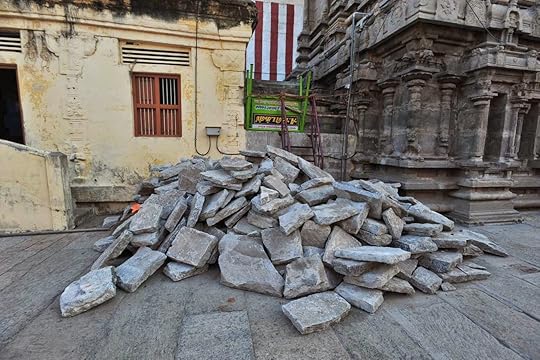
3. Shops and damage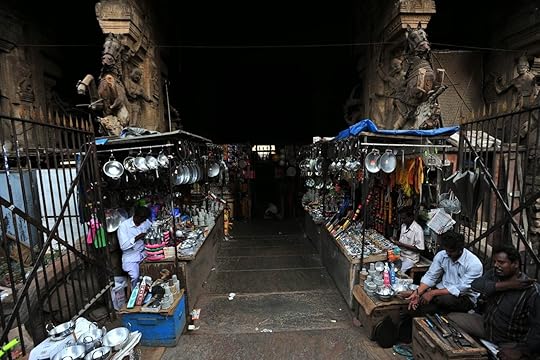 I understand that the temple is a living temple but one also needs to keep in mind its preservation. Local shops are present in the premises and though this might be a historic practice, tube lights, wiring, littering, and the breaking of limbs off horses should not be allowed. Kindly pay attention to the photographs shops 1 and shops 2. Metal struts have been crudely put in place to protect (I think) the horse sculptures. Many of the statues are damaged and much of the damage seems recent from the colour of the stone on broken areas.
I understand that the temple is a living temple but one also needs to keep in mind its preservation. Local shops are present in the premises and though this might be a historic practice, tube lights, wiring, littering, and the breaking of limbs off horses should not be allowed. Kindly pay attention to the photographs shops 1 and shops 2. Metal struts have been crudely put in place to protect (I think) the horse sculptures. Many of the statues are damaged and much of the damage seems recent from the colour of the stone on broken areas.
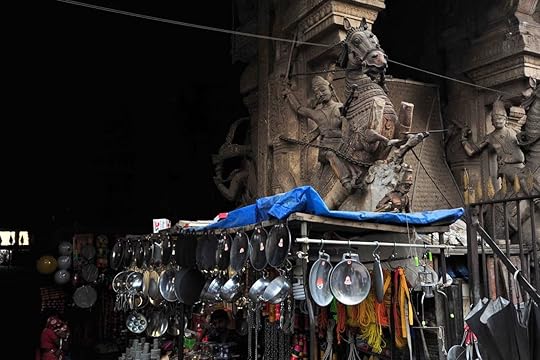
4. The "museum" or halls of a thousand pillars.Image names: Flooring and lighting, Hall of a thousand pillars and flooring - The natural lighting of these halls has been destroyed. The natural inlets for light have been sealed off and tube lights and halogen lights have been arranged around the sculptures. Rather than enhancing the aesthetic these unnecessary lights reduce the same. They are unnecessary and nowhere in the world is such cheesy lighting used to illuminate ancient sculptures. Kindly note that the photograph titled "flooring and lighting" is taken in the hall and is not a view from some government arts and handcrafts office, which seems to be the look given to this 1300-year-old hall.The flooring of this magnificent hall has been changed from the foot polished giant granite slabs of centuries used elsewhere in the temple to polished "modern" granite. It has been cemented in place all the way up to the sculptures. Bright halogen lights and tube lights reflected in a glossy polished "modern" floor do not make for the preservation and maintenance of a temple.Kindly note the possibly unnecessary and ugly stands made from enamel painted wood places in the hall. These stands serve to distract and denigrate the sculptures surrounding them. Large badly maintained stands of "coins" are placed against the wall obscuring from view the intricately carved walls. This is called the museum by the authorities here as if the sculptures and temple itself is not adequate enough.
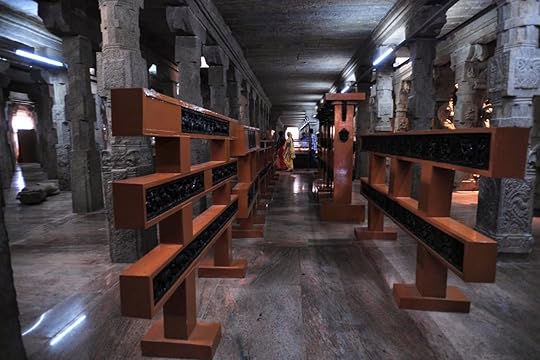
Image name - Tourists rapping on damaged sculptures: The sculptures are not protected in any way. Numerous guides take tourists to them and they are rapped on and banged on to achieve certain "sounds”. Local security shrugged off my query about the same and were later seen instructing tourists on the practice of banging on one limb and pressing ones ear to another to "hear" some sound or the other. The results are plain to see with damaged limbs on almost all the statues.
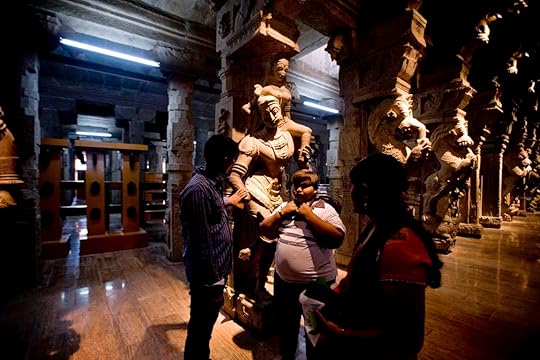
Kindly note the polished state of certain anatomical parts of the sculptures. There is NO security around these sculptures.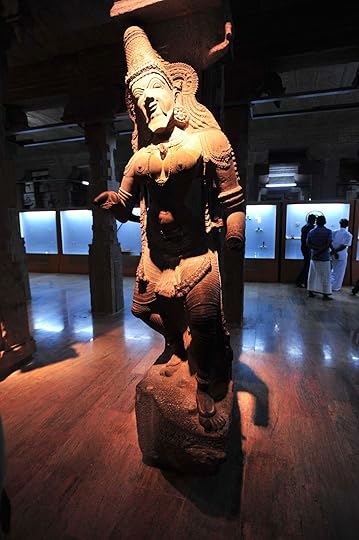 There are what seem to be old paintings arranged with no protection in this hall being touched by numerous passers by. They have been graffiti painted as seen in the photo and labeled in brown paint by the authorities.
There are what seem to be old paintings arranged with no protection in this hall being touched by numerous passers by. They have been graffiti painted as seen in the photo and labeled in brown paint by the authorities.
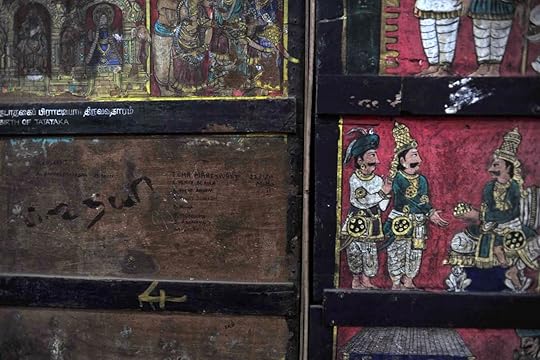
I do hope these images and descriptions are helpful. Do please feel free to get in touch with me if necessary.
Thank you kindly,
Ryan Lobo---Some information regarding this temple from Wikipedia.The Meenakshi Amman Temple is a Himdu temple located on the southern bank of the Vaigai River in the temple city of Madurai, Tamil Nadu, India. It is dedicated to Parvati, known as Meenakshi, and her consort, Shiva, here named Sundareswarar. The temple forms the heart and lifeline of the 2500 year old city of Madurai and is a significant symbol for the Tamil people, mentioned since antiquity in Tamil literature though the present structure was built between 1623 and 1655 CE.It houses 14 gopurams (gateway towers), ranging from 45-50m in height. The tallest is the southern tower, 51.9 metres (170 ft) high and two golden sculptured vimanas , the shrines over the garbhagrihas (sanctums) of the main deities. The temple attracts 15,000 visitors a day, around 25,000 on Fridays, and receives an annual revenue of sixty million rupees. There are an estimated 33,000 sculptures in the temple.It was on the list of top 30 nominees for the "New Seven Wonders of the World".
---------- Forwarded message ----------
From: Ryan Lobo
Date: Mon, Jan 30, 2012 at 11:28 AM
Subject: The Meenakshi temple. Madurai
To: directorgeneralasi@gmail.com
Cc: adg1.asi@gmail.com, adg2.asi@gmail.com, jtdg.asi@gmail.com, nationalmission@gmail.com, dircon.asi@gmail.com, dirwh.asi@gmail.com
Dear Mr. Sengupta and all other concerned authorities at the Archaeological Survey of India,
My name is Ryan Lobo and I am a photographer and film maker based in Bangalore. On a recent trip to the Meenakshi temple a few days ago, in Madurai, I photographed some changes being made to the temple, which I found (with my layman’s knowledge of our monuments) to be potentially destructive to the preservation of this temple for future generations.
I am attaching some of these photographs as I wish to bring this state of affairs to your attention. Please do pardon my presumption, a possible lack of knowledge on these matters and do forgive my errors in judgment, if any. My intentions are to help in the ASI's efforts in preservation in whatever way I can.
I understand that the temple is a living temple but one also needs to keep in mind its preservation. The current aesthetic or capacity of the local administration of the temple should not damage the structure for future generations.
1.The Ceiling

The stone ceiling has been and is being painted with motifs not necessarily in keeping with the history or mythology of the temple. i.e. Kindly note what seem to be cupids on the top right hand corner of the photo.
Tube lights are being installed all over the temple unnecessarily.The ceiling has also been painted with Enamel paint by a painter not necessarily as talented as the original sculptors of the temple. The temple might not need such embellishments, which could damage the stone as the pores do draw in the paint. The sensibilities and aesthetics of the painting seem to be more contemporary and keeping with more recent trends and ways of looking at the world rather than with the temple aesthetic.Signs, often large, painted brightly and unnecessary, are placed all over the temple. Loudspeakers (such as the one visible near "meditation hall") in photo: signs and ceiling disturb the aesthetic.

2. The Temple pond (Kindly refer photo)

A pile driver is being used to break the base of the temple pond as seen in the photograph (a.). The workman did say they were "re-tiling" the pond with "modern" tiles. The vibrations from a pile driver can damage a structure and one could feel the stone vibrate 50 meters away. This usage can damage the structure in ways not visible and can damage delicate sculptures.The large slabs of granite from the pond are being broken and removed and taken away as debris, as show in the debris photo. Is it necessary to "modernize" the tank? as I was told by the foreman instructing the labourers.
The pond has also been changed in some regards with an ornate contemporary lamp post (b) in the middle and unnecessary "gardens" in the corners (c). Large ugly tube light lit signs are present all over the temple as well. (d). The temple has been painted with glossy enamel paint all over. Even if painting is allowed should not non-enamel pigments be used?

3. Shops and damage
 I understand that the temple is a living temple but one also needs to keep in mind its preservation. Local shops are present in the premises and though this might be a historic practice, tube lights, wiring, littering, and the breaking of limbs off horses should not be allowed. Kindly pay attention to the photographs shops 1 and shops 2. Metal struts have been crudely put in place to protect (I think) the horse sculptures. Many of the statues are damaged and much of the damage seems recent from the colour of the stone on broken areas.
I understand that the temple is a living temple but one also needs to keep in mind its preservation. Local shops are present in the premises and though this might be a historic practice, tube lights, wiring, littering, and the breaking of limbs off horses should not be allowed. Kindly pay attention to the photographs shops 1 and shops 2. Metal struts have been crudely put in place to protect (I think) the horse sculptures. Many of the statues are damaged and much of the damage seems recent from the colour of the stone on broken areas.

4. The "museum" or halls of a thousand pillars.Image names: Flooring and lighting, Hall of a thousand pillars and flooring - The natural lighting of these halls has been destroyed. The natural inlets for light have been sealed off and tube lights and halogen lights have been arranged around the sculptures. Rather than enhancing the aesthetic these unnecessary lights reduce the same. They are unnecessary and nowhere in the world is such cheesy lighting used to illuminate ancient sculptures. Kindly note that the photograph titled "flooring and lighting" is taken in the hall and is not a view from some government arts and handcrafts office, which seems to be the look given to this 1300-year-old hall.The flooring of this magnificent hall has been changed from the foot polished giant granite slabs of centuries used elsewhere in the temple to polished "modern" granite. It has been cemented in place all the way up to the sculptures. Bright halogen lights and tube lights reflected in a glossy polished "modern" floor do not make for the preservation and maintenance of a temple.Kindly note the possibly unnecessary and ugly stands made from enamel painted wood places in the hall. These stands serve to distract and denigrate the sculptures surrounding them. Large badly maintained stands of "coins" are placed against the wall obscuring from view the intricately carved walls. This is called the museum by the authorities here as if the sculptures and temple itself is not adequate enough.

Image name - Tourists rapping on damaged sculptures: The sculptures are not protected in any way. Numerous guides take tourists to them and they are rapped on and banged on to achieve certain "sounds”. Local security shrugged off my query about the same and were later seen instructing tourists on the practice of banging on one limb and pressing ones ear to another to "hear" some sound or the other. The results are plain to see with damaged limbs on almost all the statues.

Kindly note the polished state of certain anatomical parts of the sculptures. There is NO security around these sculptures.
 There are what seem to be old paintings arranged with no protection in this hall being touched by numerous passers by. They have been graffiti painted as seen in the photo and labeled in brown paint by the authorities.
There are what seem to be old paintings arranged with no protection in this hall being touched by numerous passers by. They have been graffiti painted as seen in the photo and labeled in brown paint by the authorities.

I do hope these images and descriptions are helpful. Do please feel free to get in touch with me if necessary.
Thank you kindly,
Ryan Lobo---Some information regarding this temple from Wikipedia.The Meenakshi Amman Temple is a Himdu temple located on the southern bank of the Vaigai River in the temple city of Madurai, Tamil Nadu, India. It is dedicated to Parvati, known as Meenakshi, and her consort, Shiva, here named Sundareswarar. The temple forms the heart and lifeline of the 2500 year old city of Madurai and is a significant symbol for the Tamil people, mentioned since antiquity in Tamil literature though the present structure was built between 1623 and 1655 CE.It houses 14 gopurams (gateway towers), ranging from 45-50m in height. The tallest is the southern tower, 51.9 metres (170 ft) high and two golden sculptured vimanas , the shrines over the garbhagrihas (sanctums) of the main deities. The temple attracts 15,000 visitors a day, around 25,000 on Fridays, and receives an annual revenue of sixty million rupees. There are an estimated 33,000 sculptures in the temple.It was on the list of top 30 nominees for the "New Seven Wonders of the World".
Published on April 08, 2014 02:22
No comments have been added yet.



